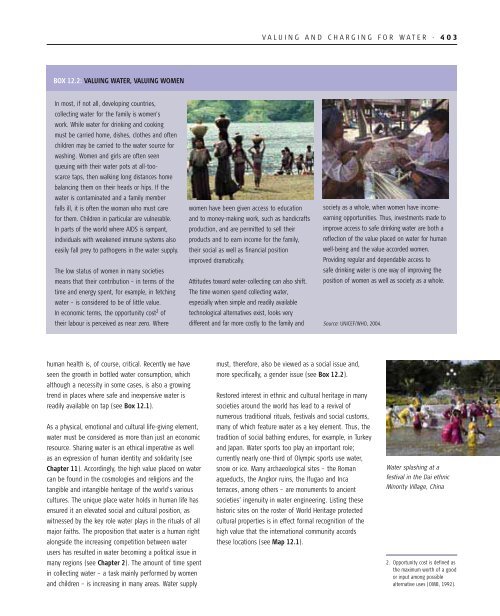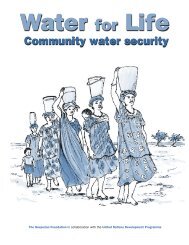Water: a shared responsibility; 2006 - UN-Water
Water: a shared responsibility; 2006 - UN-Water
Water: a shared responsibility; 2006 - UN-Water
Create successful ePaper yourself
Turn your PDF publications into a flip-book with our unique Google optimized e-Paper software.
V A L U I N G A N D C H A R G I N G F O R W A T E R . 403<br />
BOX 12.2: VALUING WATER, VALUING WOMEN<br />
In most, if not all, developing countries,<br />
collecting water for the family is women’s<br />
work. While water for drinking and cooking<br />
must be carried home, dishes, clothes and often<br />
children may be carried to the water source for<br />
washing. Women and girls are often seen<br />
queuing with their water pots at all-tooscarce<br />
taps, then walking long distances home<br />
balancing them on their heads or hips. If the<br />
water is contaminated and a family member<br />
falls ill, it is often the woman who must care<br />
for them. Children in particular are vulnerable.<br />
In parts of the world where AIDS is rampant,<br />
individuals with weakened immune systems also<br />
easily fall prey to pathogens in the water supply.<br />
The low status of women in many societies<br />
means that their contribution – in terms of the<br />
time and energy spent, for example, in fetching<br />
water – is considered to be of little value.<br />
In economic terms, the opportunity cost 2 of<br />
their labour is perceived as near zero. Where<br />
women have been given access to education<br />
and to money-making work, such as handicrafts<br />
production, and are permitted to sell their<br />
products and to earn income for the family,<br />
their social as well as financial position<br />
improved dramatically.<br />
Attitudes toward water-collecting can also shift.<br />
The time women spend collecting water,<br />
especially when simple and readily available<br />
technological alternatives exist, looks very<br />
different and far more costly to the family and<br />
society as a whole, when women have incomeearning<br />
opportunities. Thus, investments made to<br />
improve access to safe drinking water are both a<br />
reflection of the value placed on water for human<br />
well-being and the value accorded women.<br />
Providing regular and dependable access to<br />
safe drinking water is one way of improving the<br />
position of women as well as society as a whole.<br />
Source: <strong>UN</strong>ICEF/WHO, 2004.<br />
human health is, of course, critical. Recently we have<br />
seen the growth in bottled water consumption, which<br />
although a necessity in some cases, is also a growing<br />
trend in places where safe and inexpensive water is<br />
readily available on tap (see Box 12.1).<br />
As a physical, emotional and cultural life-giving element,<br />
water must be considered as more than just an economic<br />
resource. Sharing water is an ethical imperative as well<br />
as an expression of human identity and solidarity (see<br />
Chapter 11). Accordingly, the high value placed on water<br />
can be found in the cosmologies and religions and the<br />
tangible and intangible heritage of the world’s various<br />
cultures. The unique place water holds in human life has<br />
ensured it an elevated social and cultural position, as<br />
witnessed by the key role water plays in the rituals of all<br />
major faiths. The proposition that water is a human right<br />
alongside the increasing competition between water<br />
users has resulted in water becoming a political issue in<br />
many regions (see Chapter 2). The amount of time spent<br />
in collecting water – a task mainly performed by women<br />
and children – is increasing in many areas. <strong>Water</strong> supply<br />
must, therefore, also be viewed as a social issue and,<br />
more specifically, a gender issue (see Box 12.2).<br />
Restored interest in ethnic and cultural heritage in many<br />
societies around the world has lead to a revival of<br />
numerous traditional rituals, festivals and social customs,<br />
many of which feature water as a key element. Thus, the<br />
tradition of social bathing endures, for example, in Turkey<br />
and Japan. <strong>Water</strong> sports too play an important role;<br />
currently nearly one-third of Olympic sports use water,<br />
snow or ice. Many archaeological sites – the Roman<br />
aqueducts, the Angkor ruins, the Ifugao and Inca<br />
terraces, among others – are monuments to ancient<br />
societies’ ingenuity in water engineering. Listing these<br />
historic sites on the roster of World Heritage protected<br />
cultural properties is in effect formal recognition of the<br />
high value that the international community accords<br />
these locations (see Map 12.1).<br />
<strong>Water</strong> splashing at a<br />
festival in the Dai ethnic<br />
Minority Village, China<br />
2. Opportunity cost is defined as<br />
the maximum worth of a good<br />
or input among possible<br />
alternative uses (OMB, 1992).
















